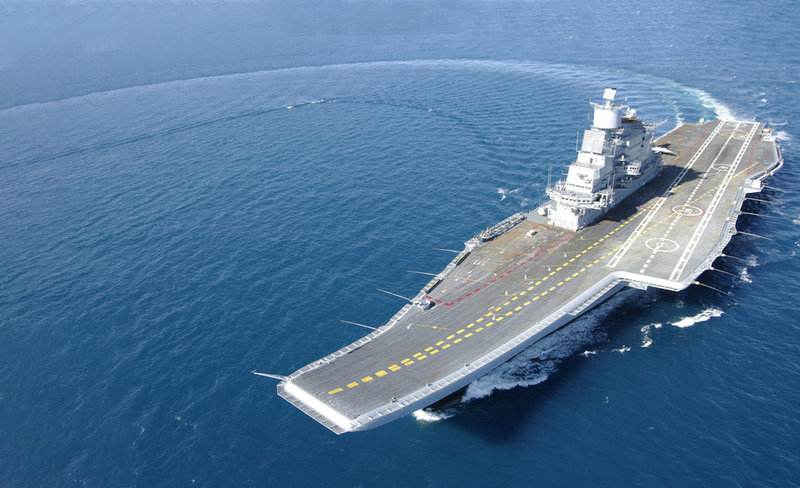Naval aviation
INS Vikrant: India’s newest aircraft carrier
India has commissioned into service the INS Vikrant, its first indigenously manufactured aircraft carrier. Richard Thomas details the platform’s capabilities.
India has commissioned into service the INS Vikrant, its first indigenously manufactured aircraft carrier. Richard Thomas details the platform’s capabilities.
Weighing in at around 43,000 tons, the INS Vikrant (IAC-1) represents the current pinnacle of India’s naval manufacturing sector and looks to have learned design lessons from its Kiev-class predecessor, which was acquired from Russia in the early 2000s.
Both INS Vikrant and the older INS Vikramaditya are short take-off but arrested recovery (STOBAR) designs, using an angled bow/ski-jump to provide additional lift for embarked aircraft on take-off. The concept was adopted by India and China, both of which have leaned heavily on Russian expertise in the development of their respective carrier programmes.
The Vikrant-class aircraft carrier has been designed by the Indian Navy’s Warship Design Bureau and constructed by Cochin Shipyard in Kochi, India. The 262m-long and 62m-wide carrier completed a series of pre-commissioning sea trials, first carried out in August 2021 and concluding later that same year.

// The older Indian Navy carrier INS Vikramaditya was acquired from Russia after heavy modification, with the general design concept maintained for the new IAC-1 carrier INS Vikrant. Credit: Indian Navy
Venkatesh Kandlikar, defence analyst at GlobalData, told Global Defence Technology that the INS Vikrant features a significant amount of Indian industrial contribution in the design and manufacturing stage, even using locally sourced steel.
However, the programme was not without its difficulties, with component and equipment delivery and supply chain issues delaying the commissioning by around five years. The programme also suffered from cost overruns, coming in at $3bn more than the initial allocated budget.
INS Vikrant (specifications)
| Displacement | 43,000t |
| Speed | 28kt |
| Endurance | 7,500nm |
| Embarked aircraft | 30 fixed- and rotary-wing |
According to Kandlikar, the Indian Navy is expected to field three aircraft carriers in its fleet by the next decade. With Vikramiditya in service and Vikrant now commissioned, India is beginning to plan the build of the future INS Vishal, which is expected to be larger still than existing carriers and feature updated technologies, such as an electromagnetic air-lift systems, also known as EMALS, as being installed on the US Navy’s new Ford-class super carriers.
“With the experience gained in the construction of IAC-1, supported by the indigenous ecosystem it is expected that the Indian Navy will soon get a green light from the Indian Ministry of Defence to start designing the third aircraft carrier,” Kandlikar said.
Air wing composition
In terms of embarked aircraft, Kandlikar said the Indian Navy was looking to deploy a new carrier air wing comprising of either F/A-18 Super Hornets or Rafale-M fighters. The Indian Air Force currently operates the conventional Rafale 4.5 generation fighter, which is manufactured by France’s Dassault Aviation, offering a commonality option for the Indian Navy.
Capability-wise, the two aircraft are similar, although the Rafale is the newer aircraft and is being heavily pushed for export. The Super Hornet, meanwhile, is entering the twilight of its naval career. Although it still broadly matches the Rafale in terms of engine thrust it, is slightly slower at Mach 1.6 compared to Mach 1.8, but with a higher payload capacity at 66,000lb (29,937kg) to the Rafale’s 54,000lb.
However, in the near-to-mid-term, India will utilise its fleet of 45 MiG-29K/KUB fighters, acquired from Russia following the signing of separate deals in 2004 and 2010. India is also developing a navalised variant of its LCA/HAL Tejas fighter, although it is not known when the platform will be integrated into the country’s carrier fleet.
The rotary component, vital for search-and-rescue and airborne early warning and surveillance roles, will be fulfilled by the Russian-supplied Kamov 31 helicopter.
// Main image: The Indian Navy has commissioned the aircraft carrier INS Vikrant into its fleet, seen here undergoing sea trials in 2021. Credit: Indian Ministry of Defence
Northrop’s Integrated Air and Missile Defence Battle Command System connects sensors and effectors that were not designed to work together into a single network.